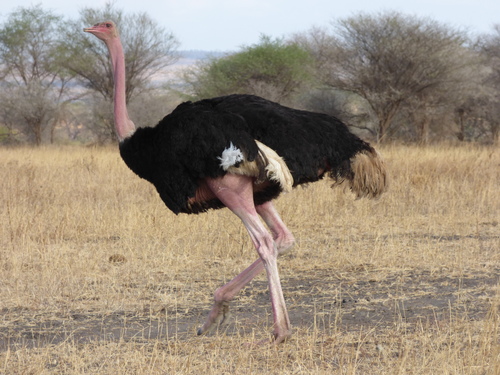
Common Ostrich
The Common Ostrich (*Struthio camelus*) is the largest living bird species on Earth, renowned for its impressive size, powerful legs, and inability to fly. Native to Africa, ostriches play a vital role in their savanna and desert ecosystems as both grazers and prey for large predators. They hold cultural significance in various African societies, often symbolizing strength, speed, and even fertility. Their unique adaptations, including their remarkable running ability, allow them to thrive in harsh environments.
180-275 cm
Length
200 cm
Wingspan
Least Concern
Conservation Status
Distribution
Native to Africa, the Common Ostrich is found across a wide range of sub-Saharan countries. Historically, their range extended into the Middle East, but they are now extinct in that region. They are primarily found in open savanna, semi-arid plains, and deserts.
Lifespan
In the wild, ostriches typically live 30-40 years, but in captivity, they can live up to 50-60 years.
Common Ostrich's Habitat
Habitat Types
Savannas, Grasslands, Semi-deserts, Open woodlands
Climate Zones
Tropical, Subtropical, Arid
Adaptations
Ostriches have several adaptations to survive in their harsh environments. Their long, powerful legs allow them to run at high speeds to escape predators. They can tolerate high temperatures and conserve water efficiently. Their large eyes provide excellent vision for spotting danger.
Variations
There are several recognized subspecies, including the North African Ostrich (*S. c. camelus*), the Masai Ostrich (*S. c. massaicus*), and the South African Ostrich (*S. c. australis*). These subspecies exhibit variations in neck color and size.
Appearance
Breeding Plumage
Male ostriches have black and white plumage, with black body feathers and white wing and tail plumes. Females and immature birds have grayish-brown plumage.
Seasonal Feather Changes
There is no significant seasonal variation in plumage, though the brightness of the male's plumage may intensify during breeding season.
Sex Based Plumage Differences
Significant sexual dimorphism exists, with males having black and white plumage and females having grayish-brown plumage.
Notable Features
Long, powerful legs with only two toes on each foot., Large eyes, providing excellent vision., Long neck, which is often bare or sparsely feathered., Strong, sharp claws on their feet.
Diet and Feeding
Primary Foods
Seeds, Grasses, Leaves, Fruits, Insects, Small vertebrates (occasionally)
Foraging Behavior
Ostriches are primarily herbivores, grazing on vegetation. They use their strong beaks to pluck leaves and seeds. They also ingest small stones (gastroliths) to help grind food in their gizzard. They will occasionally eat insects and small animals.
Specializations
Their long necks allow them to reach both low-lying vegetation and higher branches. Their gizzard, containing gastroliths, is a specialized adaptation for grinding tough plant material.
Seasonal Diet Variations
Their diet can vary depending on the availability of food. During dry seasons, they may consume more dry grasses and seeds, while during wetter seasons, they may eat more succulent plants and fruits.
Behavior
Social Structure
Ostriches are often found in small groups, typically consisting of a dominant male, several females, and their chicks. During the non-breeding season, they may form larger flocks.
Communication
Booming calls (made by males), Hissing and snapping (used as warning signals), Wing flapping and bowing (used in courtship and displays), Clucking sounds (made by chicks)
Migration
Common Ostriches are not truly migratory, but they may move locally in response to food and water availability.
Territorial or Group Behaviors
Dominant males defend territories during the breeding season. Groups maintain a social hierarchy, with the dominant male having priority access to food and mates.
Conservation
Threats
Habitat loss (due to agriculture and human settlement), Hunting (for meat, feathers, and leather), Egg collection, Climate change (increasing aridity in some areas)
Protection Programs
Ostrich farming (reduces pressure on wild populations), Protected areas (national parks and reserves)
Local National Laws
Many African countries have laws protecting ostriches, but enforcement can be challenging.
Population Trend
Stable
Population Estimates
The global population is estimated to be in the hundreds of thousands, but precise numbers are difficult to obtain.
Interesting Facts
Ostriches can run at speeds of up to 70 km/h (43 mph).
This makes them the fastest-running birds and the fastest two-legged animals on Earth.
An ostrich egg can weigh up to 1.5 kg (3.3 lbs).
This is the largest egg of any living bird species.
Ostriches have three stomachs.
These are the proventriculus (glandular stomach), the ventriculus (gizzard), and the intestines.
Ostriches do *not* bury their heads in the sand.
This is a myth. When threatened, they may lie low to the ground, making their heads less visible, but they do not bury them.
Faqs about Common Ostrich
Can ostriches fly?
No, ostriches are flightless birds. Their wings are used for balance while running and for courtship displays.
What do ostriches eat?
Ostriches are primarily herbivores, eating seeds, grasses, leaves, and fruits. They also eat insects and occasionally small vertebrates.
How long do ostriches live?
In the wild, ostriches typically live 30-40 years. In captivity, they can live up to 50-60 years.
Are ostriches dangerous?
Ostriches can be dangerous if they feel threatened. They have powerful legs and sharp claws that can inflict serious injuries. It is important to maintain a safe distance from wild ostriches.
Copyright @ Nature Style Limited. All Rights Reserved.
 English
English